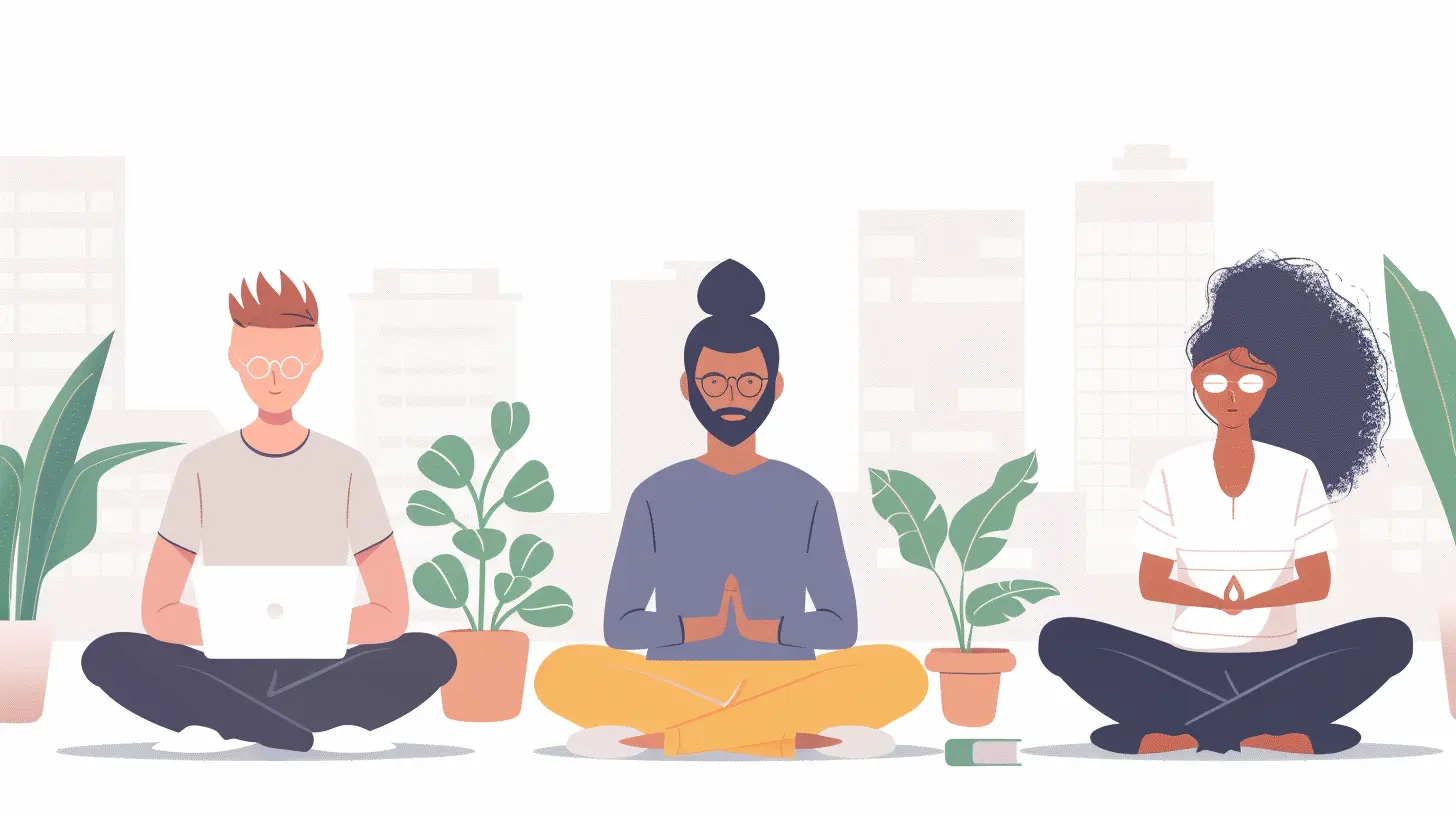Practicing Mindfulness in the Workplace: A Guide for Professionals
20 October 2025
Let’s be honest—work can be a pressure cooker. Deadlines, meetings, emails, and the constant ping of notifications can leave your brain in a fog and your stress levels skyrocketing. Sound familiar? You’re not alone. In today’s always-on culture, stress at work has become the norm. But it doesn't have to be. That’s where mindfulness comes in—a simple yet powerful practice that can literally change the way you experience your workday.
In this guide, we're diving deep into what mindfulness really means in the context of the workplace, why it matters, and how you can start weaving it into your 9-to-5. Whether you're a high-flying executive or grinding it out in a startup, mindfulness can help you boost productivity, manage stress, and honestly—just feel better.
What is Mindfulness, Really?
Let’s cut through the fluff. Mindfulness isn’t about chanting mantras or sitting cross-legged on a mountain (unless that’s your thing). It’s simply the practice of paying attention—on purpose—to the present moment, without judgment.Sounds simple, right? It is. But don’t confuse simple with easy. Our minds are like squirrels hopped up on caffeine, constantly darting from one thought to another. Mindfulness helps slow that roll, giving you a sense of clarity and calm in the middle of chaos.
In a work setting, mindfulness means being fully present in meetings, actually tasting your lunch, listening (for real) to your coworkers, and not letting your inbox run your day.
Why Mindfulness Matters at Work
You might be wondering, "How is mindfulness going to help me crush that to-do list?" Good question. Let’s break it down.1. Reduces Stress
Stress is a productivity killer. It fogs your mind, tightens your muscles, and makes you reactive instead of proactive. Mindfulness lowers cortisol levels (that’s your stress hormone), making it easier to stay calm under pressure.2. Improves Focus
When you’re mindful, you’re not multitasking (which, fun fact, is just task-switching and not actually effective). You’re laser-focused on one thing at a time, which leads to better results with less effort.3. Enhances Emotional Intelligence
Mindfulness makes you more aware of your own emotions and more empathetic toward others. That’s a win-win in any team environment, leading to better communication, fewer misunderstandings, and stronger relationships.4. Boosts Creativity
When your mind isn't cluttered with worry or distraction, you free up mental space for creative thinking and problem-solving.
Mindfulness Myths That Need Busting
Before we move on, let’s tackle a few common misconceptions:- Myth: “I don’t have time to be mindful.”
Truth: It doesn’t take hours. Even just 60 seconds of focused breathing can reset your mind.
- Myth: “Mindfulness is only for spiritual people.”
Truth: It’s a scientifically backed mental fitness tool. CEOs, athletes, and high performers use it daily.
- Myth: “If I’m being mindful, I’m not being productive.”
Truth: Mindfulness isn’t about zoning out—it’s about tuning in.
How to Start Practicing Mindfulness at Work
No incense, no chanting. Just actionable steps you can take—even if your desk is a circus and your schedule is a zoo.1. Start With Your Breath
Seriously, your breath is your biggest tool. Try this: before answering the next email, pause. Take three slow, deep breaths. That’s it. That tiny break creates space between impulse and action.You can sneak these mini breathing breaks in throughout the day—before a meeting, after a call, or when you feel tension build up.
2. Mindful Mornings
Instead of jumping straight into work or scrolling on your phone, take five minutes each morning to sit quietly. Focus on your breathing, set an intention for the day, or do a quick body scan to check in with yourself.This mini ritual creates a calm foundation that sets the tone for everything that follows.
3. Do One Thing at a Time
Multitasking is a lie we’ve been sold. It actually leads to more mistakes, more stress, and less done. Try single-tasking instead. Close those extra tabs (yes, all 27 of them), turn off notifications, and give your full attention to one task. You’ll be amazed at how much quicker and better you get things done.4. Take Tech Breaks
Constant notifications are like a toddler pulling on your sleeve—they demand attention and drain your focus. Set boundaries with your tech. Schedule phone-free zones or email check-ins a few times a day, rather than constantly refreshing your inbox.5. Build Mindful Meetings
Before diving into your next meeting, take 60 seconds for silence. This gives everyone time to arrive mentally—not just physically. Encourage people to stay present: no phones, no side chats, just active listening.Try summarizing what others say to show you’re actually hearing them. It fosters respect and keeps things focused.
6. Eat Without a Screen
Mindful eating isn’t just a cute wellness trend—it’s a way to actually enjoy your food and give your brain a break from work. Step away from your desk. Put your phone away. Chew slowly. Taste your lunch.You’re not a robot—you need time to refuel mentally and physically.
7. Label Your Thoughts
Ever had a workday where your brain was like a hamster wheel? Try this trick: when a thought pops up—"I'm going to miss the deadline!"—label it. "Worry." "Planning." "Judgment."Labeling thoughts helps you detach from them. It’s like saying hi to a thought but not inviting it to move in.
8. Use Mindfulness Apps
If you need a bit of structure, there are tons of great apps like Headspace, Calm, Insight Timer, or Ten Percent Happier. Many offer quick meditations specifically designed for workplace stress.They’re like having a calm coach in your pocket.
Creating a Mindful Culture at Work
Mindfulness isn't just a solo activity. When teams and organizations get on board, the impact multiplies.Leadership Matters
When leaders practice and promote mindfulness, it signals that well-being is a priority—not just productivity. It creates psychological safety, which makes employees feel seen, heard, and supported.Include Mindfulness in Team Rituals
Add a two-minute grounding practice at the start of team meetings. Encourage “mindful moments” during the day. Make space for honest conversations about stress and mental health.Equip Your Workspace
Natural lighting, quiet zones, standing desks, plants—all of these support a mindful workspace. It's about creating an environment that helps people feel calm and focused, not frazzled and fried.The ROI of Mindfulness
Still wondering if mindfulness is worth the effort? Let’s look at the returns:- Aetna reported saving $2,000 per employee in healthcare costs after implementing mindfulness programs.
- General Mills found that 80% of execs who took a mindfulness course noticed positive changes in decision-making.
- Google’s “Search Inside Yourself” mindfulness program is one of their most popular leadership trainings.
When people feel less stressed, more focused, and more emotionally balanced, business gets better. Culture improves. Retention goes up. Innovation rises. Everyone wins.
Common Roadblocks (and How to Get Past Them)
Let’s be real, starting a mindfulness habit can feel awkward or even pointless at first. Here’s how to get over the hump:- “It feels weird.” Yep, trying something new always does. Give it a week. What’s weird today might be your favorite moment next week.
- “I forget to do it.” Set reminders on your phone or pair it with an existing habit—like brushing your teeth or making coffee.
- “I’m too busy.” You don’t have to carve out 30 minutes. Even 1–2 minutes can make a difference.
Start small. Stay curious. Be kind to yourself.
Final Thoughts: Just Breathe
In a world that glorifies hustle, mindfulness is a quiet rebellion. It’s choosing to show up for your workday with presence, patience, and purpose. No, it won’t eliminate every stressor. But it will change how you respond to them.So the next time your inbox explodes, or your calendar looks like a game of Tetris, pause for a moment. Take a breath. And remember: even in the busiest workplace, you can find your calm.
You’ve got this.
all images in this post were generated using AI tools
Category:
MindfulnessAuthor:

Janet Conrad
Discussion
rate this article
1 comments
Zariah Reynolds
Mindfulness at work: where coffee breaks meet zen moments! Let’s trade stress for serenity and turn our offices into peaceful productivity zones. Namaste, colleagues!
November 1, 2025 at 3:24 AM

Janet Conrad
Thank you for capturing the essence of mindfulness in the workplace! Embracing moments of serenity can truly transform our work environment and boost productivity. Namaste!


